Review: Tinderbox 1.1.3

Developer: Eastgate Systems, Inc.
Price: $95; $545 (10-user); $1395 (50-user); $2495 (100-user)
Requirements: “Modern” Macintosh with 11 MB RAM and 5 MB disk space
Recommended: G3-based Mac with Mac OS 8.5 and more than 16 MB of RAM or Mac OS X
Trial: Feature-limited
Overview
Description from Eastgate Systems: “Tinderbox is a personal content management assistant. It stores your notes, ideas, and plans. It can help you organize and understand them. And Tinderbox helps you share ideas through Web journals and Web logs.”
Installation
Simply place the folder containing the Tinderbox application in whatever location you wish.
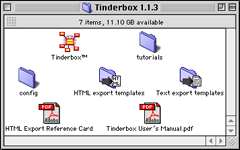
Tinderbox Folder
Using Tinderbox
The basic unit of Tinderbox is the Note. Notes have titles and may contain text and graphics. (Movies and sounds are not supported.) Notes are created and displayed within a Tinderbox window. The window types are Map, Chart, Outline, Treemap, Explorer, HTML, and Nakakoji. The Map window allows you to arrange and organize multiple notes visually.
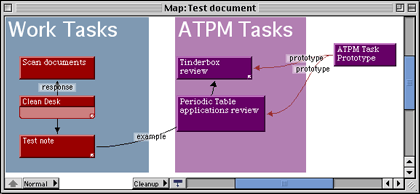
Map View Window
Notes can be created by double-clicking a blank area of the Map or Outline window, by choosing “Create Note…” from the Note menu (Command-K), by clicking the “Create Note” button (asterisk button) on the Toolbar, or by dragging a text file onto any view window.
 |
Toolbar Palette |
The Create Note dialog box is used to assign a title, color, prototype (template), sorting characteristics, and other attributes.

Create Note Dialog Window
When the dialog box is closed, an empty note window appears with a blinking text cursor. Text characteristics will be based on the chosen prototype or on the default settings (modifiable via the “Tinderbox Preferences…” dialog box).

Tinderbox Preferences Window
Notes may linked to one or more other notes. Links are visible as arrows in the Map and Treemap views. Each link is labeled with a category or description. Built-in descriptors are: agree, disagree, clarify, example, exception, note, note+, prototype, response, update. Links can be created in the Map window by selecting a Note tile, clicking on the arrow button at the bottom, and dragging to another Note tile. Links may also be established by selecting a note and clicking on the “Make link” button at the bottom of any of the View windows or by selecting a note and using the “Create Link…” menu item (Command-Option-L).
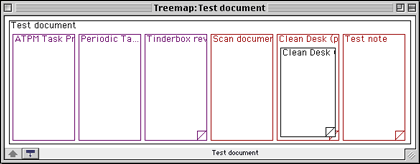
Treemap View Window
Hierarchies are established by dragging a ‘child’ note into a ‘parent’ note. These relationships are easiest to follow in the Outline, Explorer, and Chart windows. Background “Adornments” are used to highlight and organize Note tiles in the Map view. Prototype (template) Note tiles can be used to create groups of notes with identical size, color, and text characteristics. Alterations to the Prototype affect all linked Note tiles. Groups of notes may receive similar attributes without linking to a Prototype by using Stamps. Each Tinderbox Stamp contains a single attribute. Stamps are created by selecting “Edit Stamp…” from the Value menu. Each document’s stamps appear within the Value menu. Multiple stamps can be applied to groups of notes.
A feature useful to many owners of Tinderbox is the ability to assign actions to a note, including the displaying of Web page or e-mail content. The Web page content can appear within the note as HTML code, or the note can launch a Web browser to display the page.
Tinderbox also uses Agents. Agents are filters that select notes based on the content of Note titles and their text, on note linkages, and on note relationships. Actions can be assigned to Agents so that all notes that meet the selection criteria can be acted on simultaneously.
In the Outline and Chart views you can see the relationships among Note tiles. Note titles can be rearranged by dragging. The Note menu contains commands for moving notes, promoting or demoting notes, and creating or editing links between notes. Note characteristics can also be modified via a contextual menu (Control-click or click-hold).
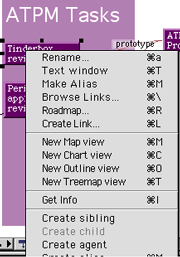
Note Contextual Menu
You can also expand or collapse outline levels for a single note or for the entire set of notes. The Explorer view uses a split window format. The Outline, Map, or Chart view appears in the left pane, and the contents of the selected Note appear in the right pane. The divider between panes may be repositioned, and the entire window is resizable.
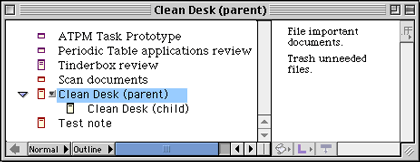
Explorer Window in Outline mode
The HTML Export and Nakakoji (text export) views are used to format notes for export. Pre-built templates are available for both formats, and new templates can be created. HTML export maintains links between notes and will place images appropriately.

Text Export Window
Documentation
The application comes with a 163-page (7" x 5.5") PDF manual. You need Adobe Acrobat Reader 5 to view the manual. The manual gives brief descriptions of how to use Tinderbox, but detailed examples are absent. It does not even include a listing of all the actions and agents, much less a description of how to use them. Tinderbox supports AppleScript, but nothing about AppleScript is in the manual.
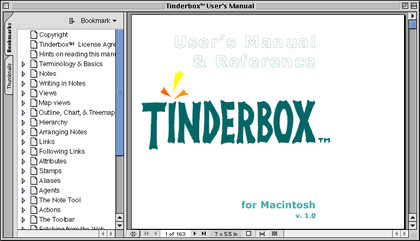
Tinderbox PDF Manual
Technical Support
Eastgate Software has telephone, fax, e-mail and snail mail addresses for feedback. There is no specific mention of technical support in the application and its PDF manual. The Eastgate Systems Web site has frequently asked questions pages for making notes and Weblogs with Tinderbox.
Eastgate Software offers training in Boston and New York. On site (individual or corporate) training can be arranged. Eastgate Software also maintains a listing of qualified consultants.
Problems, Bugs, and Omissions
Tinderbox is unstable and crashed numerous times during my review. Most crashes simply quit the application. However, a hard crash occurred after an image file was pasted into a note.
There is no easy way to change the font and formatting of a note. You must use the Get Info function, scroll down to font, click the Edit button, and type in the name of the font you wish to use. Deleting a prototype note causes related notes to lose their formatting. Changing the text font in other views is sometimes impossible, even when the Font menu appears to be active.
The height and width attributes do not work correctly in Map View. The displayed size at Normal magnification is approximately half the size listed under HTML height and width.
Tinderbox did not display its HTML export templates, even though the folder was selected in the template pop-up menu. Instead, Tinderbox displayed the contents of the folder containing the “HTML export templates” folder. (I could sometimes work around this by placing an empty folder in the “HTML export templates” folder and selecting it in the template pop-up menu.)
Occasionally, Tinderbox responded sluggishly to mouse clicks and drags. The Edit menu’s highlighting flickered intermittently.
Strengths
- Free-form notes easily can be organized, linked, and placed into hierarchies.
- There are multiple ways of viewing related information.
- You can export all or some notes in HTML or text formats using modifiable templates.
- Links to static or active Web pages (URLs) can be created.
- Agents effectively turn a Tinderbox file into a database of notes.
- Actions can automate processes based on content.
Weaknesses
- Cannot directly select links and cannot control the path of the links in Map view.
- Cannot create styled outlines within Tinderbox.
- Unusual interface, nonfunctional font menus, and difficult modification of text attributes in various views.
- Instability.
Alternatives
Inspiration (Inspiration Software, $69) has many features of Tinderbox (including URL links) and has better outlining capabilities. It is also less expensive than Tinderbox ($69 vs. $95 for single user). I reviewed Inspiration 6 last year and prefer it to Tinderbox.
HyperCard (Apple Computer, Inc., $99) can perform many of the tasks done by Tinderbox. It works even better for concept mapping when supplemented with a program such as HyperGASP (Caliban Mindwear, $75).
Summary
I found Tinderbox to be both intriguing and frustrating, intriguing because of its many ways of displaying relationships among bits of information (Notes) and because of its potential power for organizing and acting on information (Attributes, Agents, and Actions), frustrating because its interface is not intuitive and because it has a steep learning curve (and a mediocre manual). I would recommend it to users who need to organize many pieces of independent information and who have the patience and ability to become a Tinderbox power user. Tinderbox users should remember to save all open files often in case of crashes.
Reader Comments (1)
Even the beta releases have been solid. Here's a sample, from today's email:
"Just wanted to let you know that I've used 1.5b4 intensely for more than a week and, except for cosmetic errors, it seems stable and working. You have to emphasize the new prototype-setting actions. They work wonders and makes an already incredible tool even more fluent in use."
Obviously if Tinderbox weren't rock solid, people wouldn't use it so widely for weblogs. Web log writing is very demanding since a crash (or even a delay) disrupts your workflow. Things do go wrong -- that's what tech support is for -- but things don't go very wrong with Tinderbox very often.
Add A Comment